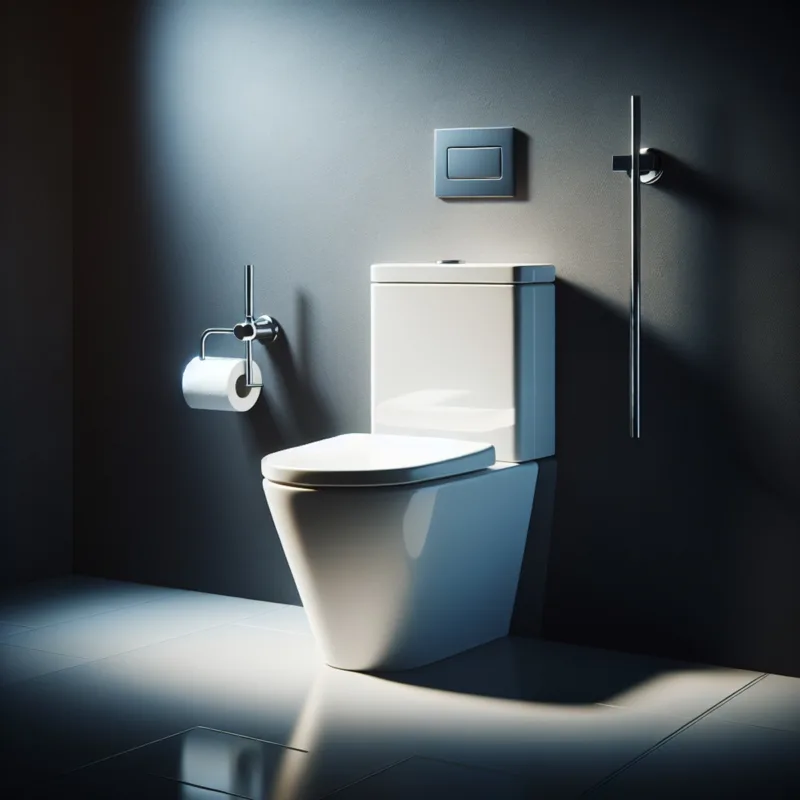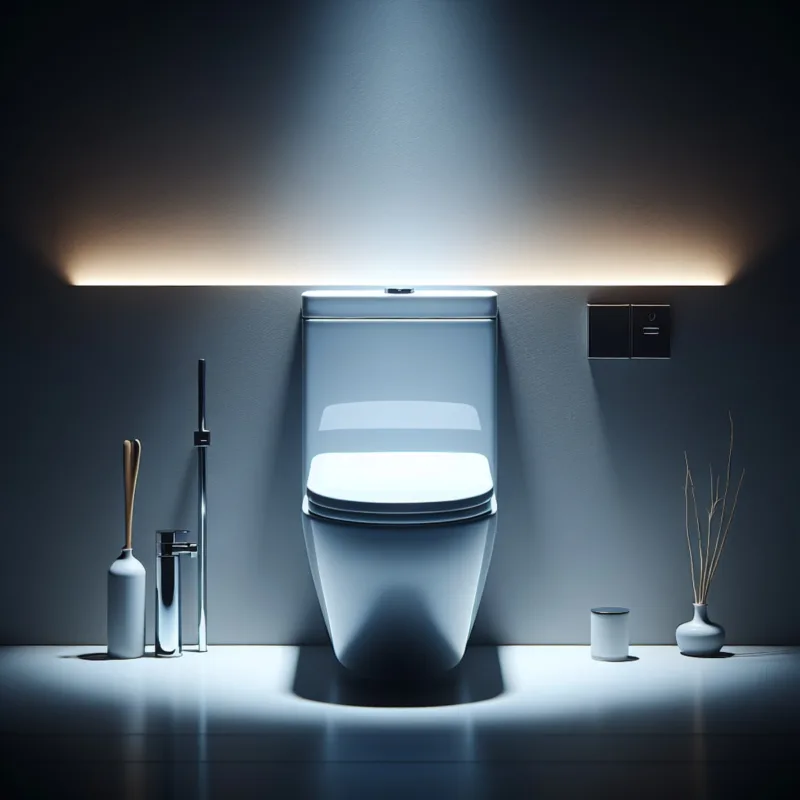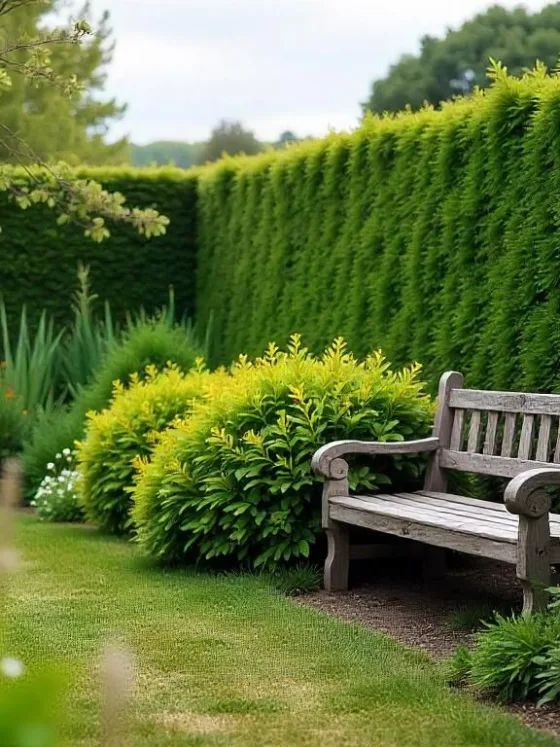Table of Contents Show
Introduction
When it comes to sprucing up the loo, the decision between a sleek wall-hung toilet and the trusty standard toilet isn’t just a toss-up—it’s a commitment.
Imagine, if you will, a wall-hung toilet: the epitome of minimalist chic, seemingly floating in space, with the plumbing cleverly concealed within the wall. It’s like having a modern art piece you can sit on!
Now, cast your eyes upon the classic standard toilet—reliable, and familiar, with its visible tank and bowl firmly rooted to the floor.
Choosing between these porcelain thrones is more than just a style preference; long-term satisfaction with your bathroom sanctuary hangs in the balance.
The key factors that come into play include:
- Cost: What are you willing to fork out now versus saving over time?
- Installation: Are we talking DIY weekend project or “Call in the experts”?
- Maintenance: How much elbow grease are you prepared to invest in keeping things sparkling?
- Design: Will it be a futuristic vibe or a nod to time-honored tradition?
This guide is here to escort you through this decision-making process with finesse. Ready to dive deep into toilets? Let’s flush out all the details so you can make that informed choice!
1. Design and Compatibility
When it comes to your bathroom, the toilet can be more than just a necessity—it can be a statement piece that complements the overall style. Both wall-hung and standard toilets come in a variety of designs, ranging from sleek and modern to traditional and timeless.
Design Options
- Wall-hung toilets: minimalistic design, clean lines, modern look
- Standard toilets: classic charm, various shapes, styles, colors
Wall-Hung Toilets
Wall-hung toilets are often seen as the more modern option. They offer a streamlined look that can make your bathroom feel more spacious and contemporary. Furthermore, with the tank concealed in the wall, only the bowl is visible, adding to their sleek appeal.
Standard Toilets
Standard toilets offer a classic charm with a wider variety of shapes, styles, and colors to choose from. This makes them a versatile choice that can fit well into any bathroom decor scheme.
Regardless of personal taste, it’s essential to choose a toilet design that matches not just your aesthetic preferences but also your bathroom’s existing style. This ensures cohesion and avoids any jarring dissonance in design.
Compatibility Considerations
- Wall-hung toilets: sturdy walls, space for concealing tank
- Standard toilets: adequate floor space, distance from other fixtures
Wall-Hung Toilets
Wall-hung toilets require sturdy walls capable of supporting weight and enough space to conceal the tank. Depending on the construction of your house or apartment, this might involve some significant modifications which could prove challenging.
Standard Toilets
Standard toilets are generally easier to integrate into existing plumbing systems due to their straightforward installation process. However, they still require an adequate floor space and distance from other fixtures as per building codes.
For those looking for a seamless blend of aesthetics and functionality in their bathrooms, exploring painting techniques that help achieve sharp lines on textured walls might be beneficial. This can enhance the overall look of your bathroom, regardless of your chosen toilet type.
Remember: whether you lean towards wall-hung or standard toilets, considering both design options and compatibility with your existing infrastructure is crucial to making an informed decision.
2. Cost Considerations
When comparing the costs of wall-hung toilets and standard toilets, there are several factors to consider. These include upfront costs, long-term savings, and additional expenses that may arise.
Upfront Costs vs Long-Term Savings
In terms of upfront costs, standard toilets are usually more affordable. They come in various styles and colors to match your preferences. However, it’s important to keep in mind that installation costs may vary depending on your plumbing setup.
On the other hand, wall-hung toilets tend to be more expensive due to their sleek design and space-saving features. Although they require a higher initial investment, they can provide significant long-term savings. For example, their water-saving capabilities might result in lower utility bills over time. Additionally, their raised design makes cleaning easier, potentially saving you time and reducing the amount of cleaning products needed.
Here’s a breakdown of the cost comparison:
- Standard Toilets: Lower purchase cost, and installation expenses based on plumbing layout.
- Wall-Hung Toilets: Higher purchase cost (including separate seat/tank purchase), potential water-saving features leading to lower utility bills over time.
Additional Cost Factors
When planning your budget for a new toilet, it’s essential to consider other expenses beyond the initial purchase price:
- Installation Requirements: Installing a wall-hung toilet may involve structural modifications in your bathroom, such as reinforcing part of the wall or creating an in-wall tank system. These changes can significantly increase your total costs.
- Maintenance Needs: Standard toilets are generally easier (and cheaper) to repair due to their traditional bowl-and-tank design. Repairs for wall-hung toilets can be more complex due to their concealed tank system—although some models have access panels for easier repairs.
Navigating through these various costs can feel overwhelming, but it’s important to remember that a higher upfront cost might lead to long-term savings. Finding the right balance between your budget and bathroom requirements is key. After all, the goal is to find a perfect toilet that fits your needs without breaking the bank.
3. Installation Complexity and Expenses
When it comes to installing a toilet, there are two main factors to consider: the complexity of the installation process and the potential expenses involved. Let’s take a closer look at each.
Installation Complexity
Different types of toilets have different installation requirements:
Wall-Hung Toilets
- These toilets have a sleek and modern design, but their installation can be quite intricate.
- They often require significant wall work, such as removing and reinforcing part of the wall.
- This is because the tank needs to be housed within the wall, which requires sturdy support for both the tank and bowl.
- In some cases, adjusting plumbing systems may also be necessary to accommodate the new layout.
Standard Toilets
- These toilets have a more traditional bowl-and-tank design that sits on the floor.
- Their installation process is generally simpler and can usually be done with basic plumbing knowledge.
- However, it’s important to note that even though they are easier to install, an incorrect installation can still cause issues like leaks or improper functioning.
DIY vs Professional Help
If you’re considering installing a toilet yourself, here are a few things to keep in mind:
- Installing a standard toilet is usually achievable for a DIYer with some plumbing skills.
- However, due to its complexity, it’s generally best to hire professionals to install a wall-hung toilet.
- This ensures that the job is done correctly and reduces the risk of future problems.
Potential Expenses
When it comes to hiring professional help for toilet installation, here’s what you need to know:
- The cost of hiring an expert to install a standard toilet typically ranges from $200 to $500, depending on your location.
- However, it’s important to consider that this cost could increase significantly if you choose to install a wall-hung toilet due to its more involved installation procedure.
Remember, while it might be tempting to save money by installing yourself or opting for a cheaper service, it’s crucial to prioritize the quality of the job. A poorly installed toilet can lead to various problems in the future, including leaks and structural damage.
4. Durability, Maintenance, and Warranties
When choosing between wall-hung and standard toilets, it’s important to consider their durability, maintenance needs, and warranties.
Durability
Wall-Hung Toilets: These toilets are built to last. Despite their sleek design, they are sturdy and can support over 500 pounds of weight, making them suitable for any household.
Standard Toilets: Known for their strength, these toilets are made of durable ceramics that can withstand years of use without significant damage.
Maintenance Needs
Wall-Hung Toilets: Keeping these toilets in good condition requires some extra effort due to their concealed tank system. When repairs are necessary, accessing the tank inside the wall can be complicated. However, certain models come with an access panel for easier maintenance.
Standard Toilets: With a simple design, these toilets are generally easier to maintain. Parts can be easily obtained from hardware stores as they are widely available. The only drawback is that dirt may accumulate around the base, requiring more frequent cleaning.
Warranties
Most toilet manufacturers offer warranties for both wall-hung and standard toilets. However, the details may vary among brands. It is common to find one-year warranties that cover manufacturing defects for both types.
For instance, Kohler provides a one-year limited warranty for their products, including wall-hung and standard toilets. This warranty covers any defects caused during manufacturing but excludes damage from misuse or improper installation.
On the other hand, Toto offers a slightly longer coverage period with a three-year limited warranty for their high-end models like wall-hung toilets, as well as a one-year warranty for standard models.
Before making a purchase decision, always check the warranty terms to ensure you are protected in case of any issues.
5. Space-Saving Benefits for Small Bathrooms
When designing or renovating a small bathroom, every inch counts. And this is where wall-hung toilets truly shine. With their sleek, streamlined design and tank concealed within the wall, these fixtures can save up to 10 inches of precious floor space compared to their floor-mounted counterparts.
Consider the dimensions: A standard toilet extends approximately 27-30 inches from the wall. On the other hand, a wall-hung model only projects around 18-20 inches into your bathroom. It’s not just about numbers though – the unobstructed floor beneath a wall-hung toilet creates an illusion of more space, making the room feel larger and airier.
However, let’s not count out standard toilets altogether when it comes to spatial efficiency. Here are some practical tips to amplify your bathroom’s real estate, no matter which toilet type you choose:
- Thoughtful Placement: Position your toilet in a corner or against one wall rather than in the middle of your bathroom. This frees up central space for movement.
- Opt for Round Bowls: If you’re going with a standard toilet, select a round bowl instead of an elongated one. Round models extend less into the room, saving a few extra inches.
- Use Shelves and Wall Storage: Maximize vertical space with wall-mounted cabinets or shelves above your toilet. This area often goes unused but can house toiletries or decorative items.
Remember, it’s not just about choosing the right toilet but also utilizing clever design techniques that work in harmony with your choice. Whether you opt for a trendy wall-hung or a classic standard toilet, thoughtful placement and smart storage solutions will ensure your small bathroom feels spacious and functional.
6. Cleaning Ease and Hygiene Considerations
When it comes to choosing a toilet, cleanliness is key. A clean bathroom not only looks good but also promotes good hygiene. Let’s compare how wall-hung toilets and standard toilets fare in terms of cleaning.
Wall-Hung Toilets: Easy to Clean?
Floating Above the Fray One major advantage of wall-hung toilets is how they make floor cleaning a breeze. Since there’s no base on the ground, you don’t have to struggle to mop around them.
Fewer Hiding Spots With less contact with the floor, wall-hung toilets have fewer nooks and crannies for dirt and grime to hide. This means less time spent scrubbing and more time enjoying your clean bathroom.
Better Hygiene The elevated design of wall-hung toilets also contributes to better hygiene. Plus, the adjustable heights can be beneficial for people with mobility issues, making it easier for them to keep their space tidy.
Standard Toilets: The Traditional Cleanup
Dealing with the Base The conventional design of standard toilets means dealing with the seam between the toilet and the floor. This area tends to accumulate dirt and even spider webs, requiring some extra effort to clean.
Watch out for Condensation Another thing to keep in mind with standard toilets is condensation on the tank, which can lead to mildew or damage to your flooring. Regularly checking for moisture and addressing it promptly will help maintain a dry and sanitary environment.
Tips for Keeping Your Toilet Spotless
Here are some tips to help you maintain a sparkling clean toilet, regardless of whether you choose a wall-hung or standard model:
- Daily Wiping: Take a moment each day to wipe down your toilet with a disinfectant solution. This simple step can prevent buildup and keep your toilet shiny.
- Deep Cleaning Tools: Be prepared with the right cleaning products, such as a quality toilet bowl cleaner, microfiber cloths, and an all-purpose disinfectant spray.
- Handling Grout: Grout lines between tiles can be a breeding ground for mold. Use a specialized grout cleaner to tackle any mold growth and keep your bathroom tiles looking fresh. For effective ways to remove and prevent mold on grout, check out this helpful guide.
- Choose the Right Cleaners: Opt for non-abrasive cleaners to avoid scratching your toilet fixtures. This gentle approach will help them maintain their glossy finish.
Remember, whether you go for the sleek wall-hung design or stick with the traditional standard toilet, staying on top of cleaning tasks will save you from future headaches. Regular maintenance is key to keeping any toilet in top shape. Now, let’s move on to another important factor to consider when choosing a toilet – but don’t worry, no spoilers here; keep reading!
Conclusion
Selecting the right toilet, whether it’s a sleek wall-hung toilet or a classic standard toilet, depends on various factors that are specific to your situation. Consider your personal preferences carefully, taking into account the practicality of your bathroom space. It’s important to find a balance between the appearance and functionality of the toilet.
For those who are interested in modern design and value every inch of space, the wall-hung toilet offers both style and space-saving features. Its raised bowl makes it more accessible, which is beneficial for households with older people or disabled members.
On the other hand, if you’re looking for a toilet that is easy to install, the standard toilet is a reliable choice. It comes in various styles and is easier to maintain compared to wall-hung toilets.
Now that you have all the information you need, feel confident as you make your decision. Trust yourself and create a bathroom that not only meets your needs but also exceeds your expectations. Good luck with finding the perfect toilet!
FAQs(Frequently Asked Questions)
Wall-hung toilets offer a minimalistic design with clean lines, providing a modern look for your bathroom.
Standard toilets offer a classic charm with a wider variety of design options to choose from, catering to different aesthetic preferences.
Wall-hung toilets require sturdy walls capable of supporting the toilet’s weight and space for concealing the tank, making them suitable for bathrooms with specific structural requirements.
In terms of upfront costs, standard toilets are usually more budget-friendly compared to wall-hung toilets.
When budgeting for a new toilet, it’s essential to consider installation expenses, potential professional help, and any additional features or accessories required.
Wall-hung toilets have a sleek and modern design but their installation may require professional help due to their specific mounting and support needs.
Keeping wall-hung toilets in good condition requires regular maintenance to ensure their durability and functionality over time.
Yes, most toilet manufacturers provide warranties for both wall-hung and standard toilets to cover any potential defects or issues.
Wall-hung toilets can be advantageous in small bathrooms as they create an illusion of more space by floating above the floor, making cleaning and maintenance easier.
Wall-hung toilets are generally easier to clean due to their elevated position, while standard toilets may require more effort to reach tight spaces around the base. Proper maintenance is essential for maintaining hygiene regardless of the type chosen.












